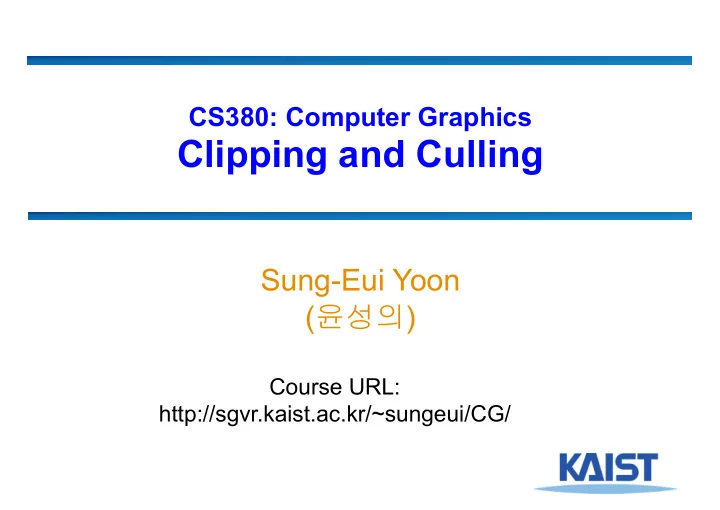

CS380: Computer Graphics Clipping and Culling Sung-Eui Yoon ( 윤성의 ) Course URL: http://sgvr.kaist.ac.kr/~sungeui/CG/
Class Objectives ● Understand clipping and culling ● Understand view-frustum, back-face culling, and hierarchical culling methods ● Know various possibilities to perform culling and clipping in the rendering pipeline ● Related chapter: ● Ch. 6: Clipping and Culling 2
Questions on last lecture ● the lecture slide specifies that we need to submit the question 2 times in a semester. does it mean “at least” two times? if not, this is my third question so is it going to be disregarded? ● my previous questions were left unanswered. may I ask them via e-mail to the professor? 3
Questions on last lecture ● It is mentioned in the class today that GPUs are made up to deal with specific tasks so their cores are much simpler than CPU. ● But I remember that in the earlier lecture it was also mentioned that GPU is getting more flexible and could run more programs, isn’t this flexibility making GPU become like CPU? isn’t it breaking our primary reasoning to separate GPU and CPU in the first place? 4
Culling and Clipping ● Culling ● Throws away entire objects and primitives that cannot possibly be visible ● An important rendering optimization (esp. for large models) ● Clipping ● “Clips off” the visible portion of a primitive ● Simplifies rasterization ● Also, used to create “cut-away” views wiki 5
Culling Example Power plant model (12 million triangles) 6
Culling Example Full model View frustum culling Occulsion culling 12 Mtris 10 Mtris 1 Mtris 7
Lines and Planes ● Implicit equation for line (plane): n ˆ d (0,0) ● If is normalized then d gives the distance of the line (plane) from the origin along 8
Lines and Planes ● Lines (planes) partition 2D (3D) n ˆ space: ● Positive and negative half-spaces l p 0 ● The intersection of negative half- d spaces defines a convex region l p 0 (0,0) 9
Testing Objects for Containment + + + + - + - - - + + + - - - Outside Straddling Inside 10
Conservative Testing r r c c r c Indeterminate Inside Outside ● Use cheap, conservative bounds for trivial cases ● Can use more accurate, more expensive tests for ambiguous cases if needed 11
Hierarchical Culling ● Bounding volume hierarchies (BVHs) ● Accelerate culling by rejecting/accepting entire sub- trees at a time ● Uses axis-aligned bounding boxes ● Also known as object partitioning hierarchies A BVH 12
Hierarchical Culling w/ BVH ● Simple traversal algorithm: while( node is indeterminate ) recurse on children Indeterminate not visited visited Inside Indeterminate Inside Inside Indeterminate Outside 13
Test-Of-Time 2006 Award RT-DEFORM: Interactive Ray Tracing of Dynamic Scenes using BVHs Christian Lauterbach, Sung-eui Yoon, David Tuft, Dinesh Manocha IEEE Interactive Ray Tracing, 2006 14
View Frustum Culling ● Test objects against planes defining view frustum ● How do you compute them? M 1 -1 1 -1 ● Other planes can be computed similarly 15
Back-Face Culling ● Special case of occlusion - convex self- occlusion ● For closed objects (has well-defined inside and outside) some parts of the surface must be blocked by other parts of the surface ● Specifically, the backside of the object is not visible 16
Face Plane Test ● Compute the plane for the face: ● Cull if eye point in the negative half-space 17
Back-Face Culling in OpenGL ● Can cull front faces or back faces ● Back-face culling can sometimes double performance if (cull): glFrontFace(GL_CCW) # define winding order glEnable(GL_CULL_FACE) # enable Culling glCullFace(GL_BACK) # which faces to cull else: glDisable(GL_CULL_FACE) You can also do front-face culling! 18
Clipping a Line Segment against a Line ● First check endpoints against the plane ● If they are on the same side, no clipping is needed ● Interpolate to get new point ● Vertex attributes interpolated the same way 19
Clipping in the Pipeline Option 1 View/Projection transformations What is the best place? Option 2 - Option 2 (clip space) Homogeneous divide 1 -1 1 Option 3 -1 (NDC space) 20
View Frustum Clipping in NDC Space ● Points in projective space need to be clipped before projection ● Primitives that straddle the z=0 plane “flip” around infinity when projected project then view frustum draw gives you this near plane we don’t want to see this part clipped point z 0 eye 21
Clipping in the Clip Space ● NDC simplify view frustum clipping ● Clip after applying projection matrix, but before the divide by w; we call that space clip space w x -1 1 ● Easy in/out test and interpolation 22
Culling and Clipping in the Rendering Pipeline View frustum culling, but performed in the application level View frustum clipping and back-face culling can be done here Back-face culling done in setup phase of rasterization 23
Class Objectives were: ● Understand clipping and culling ● Understand view-frustum, back-face culling, and hierarchical culling methods ● Know various possibilities to perform culling and clipping in the rendering pipeline 24
Homework ● Go over the next lecture slides before the class ● Watch 2 SIGGRAPH videos and submit your summaries before every Mon. class ● Submit your questions two times during the whole semester 25
Next Time ● Rasterizing triangles ● Triangulating a polygon ● Interpolating parameters 26
Recommend
More recommend